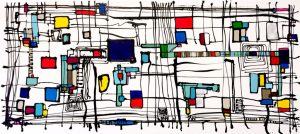In my understanding, authenticity derives from something being genuine and original with no hint of replication or plagiarism. However, to be truly authentic is a strange concept; more art is created than can ever be consumed and any “original” idea has surely been tried before in one form or another. Amongst billions, the idea that the work of one person is completely original seems impossible. I also believe that all our art has some form of influence behind it, whether it be from previous artwork or styles we have encountered or if it comes from the environment we inhabit – with this being said, is any piece of art the work of purely one person’s imagination, and does this make the work unauthentic? I believe authenticity is a layered concept – an original piece designed in a way that has never been popularised or what breaks expected artistic norms would be, in my opinion, truly authentic.
The idea of breaking artistic boundaries relates to the Modernist movement, which brought broad experimentation with shape, colour and medium into mainstream art culture throughout the 20th century. In contemporary practice, I believe the principles of modernism still hold value; the abstract like aesthetic of modernist work may have been replicated time and time again, but contemporary modern artists continue to experiment with artistic boundaries to break the established “rules” of art. For example, Glen Josselsohn (Landscape 1), who’s vivid, abstract pieces shows his innovative work with colour and geometric shape to break the traditional norms, demonstrating authentic work with modernist values.
like aesthetic of modernist work may have been replicated time and time again, but contemporary modern artists continue to experiment with artistic boundaries to break the established “rules” of art. For example, Glen Josselsohn (Landscape 1), who’s vivid, abstract pieces shows his innovative work with colour and geometric shape to break the traditional norms, demonstrating authentic work with modernist values.
Bibliography:
- Josselsohn, G. (n.d) Landscape 1. [image]. Available at: http://glenjosselsohn.com/portfolio/ [Accessed 01/11/17]
